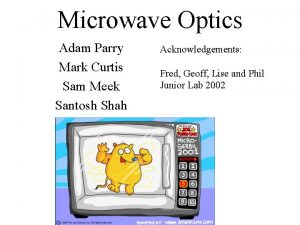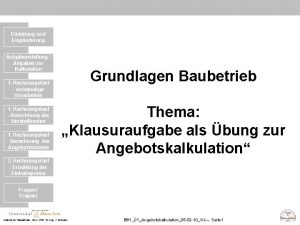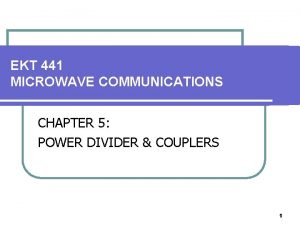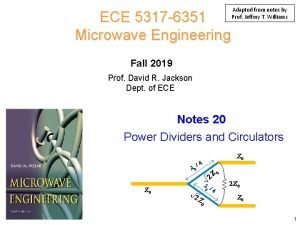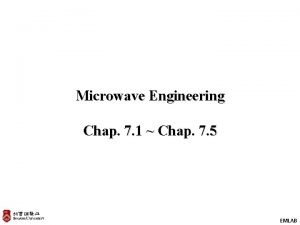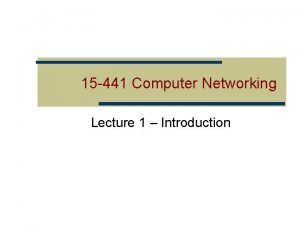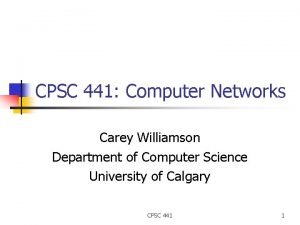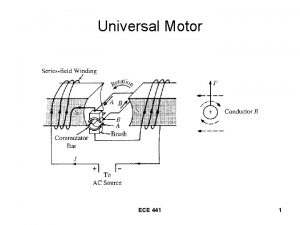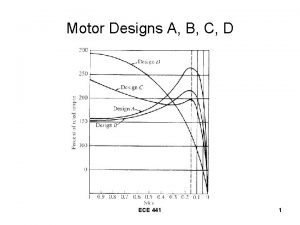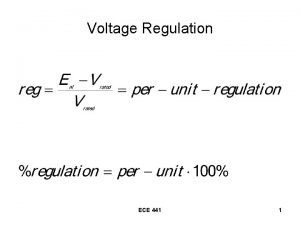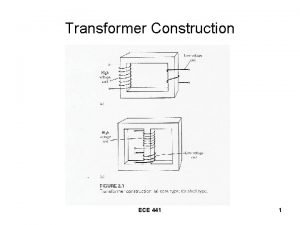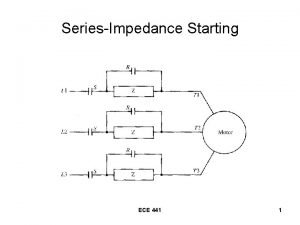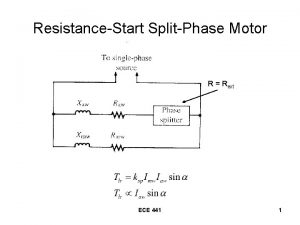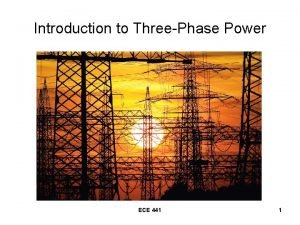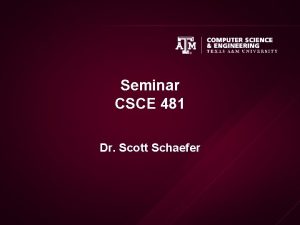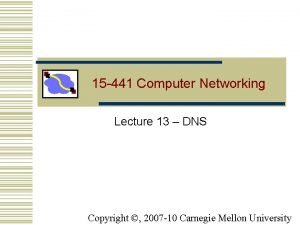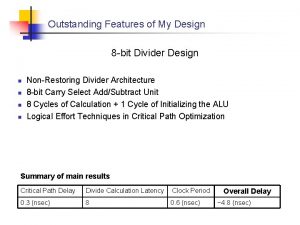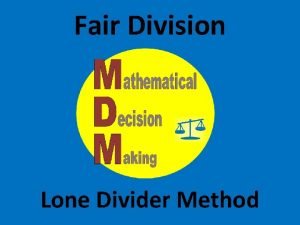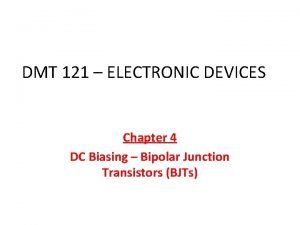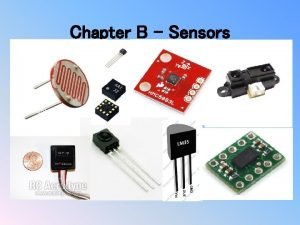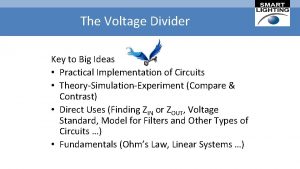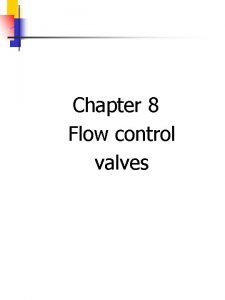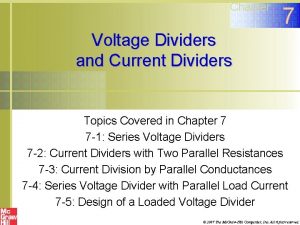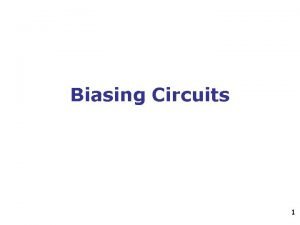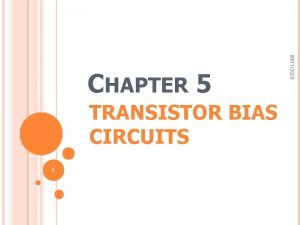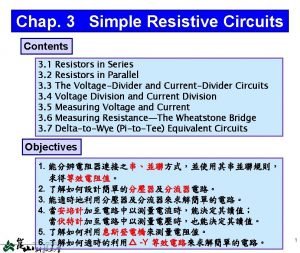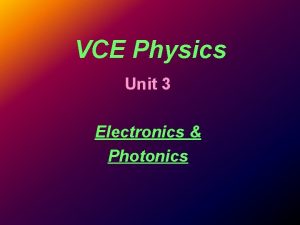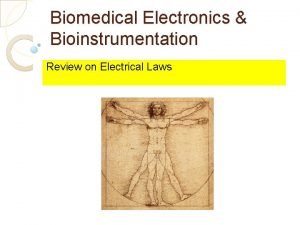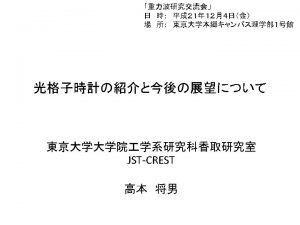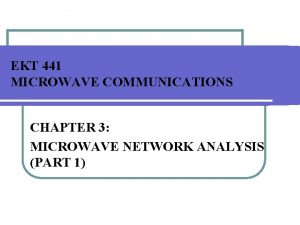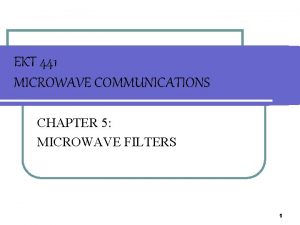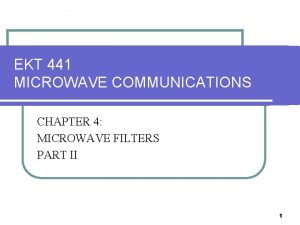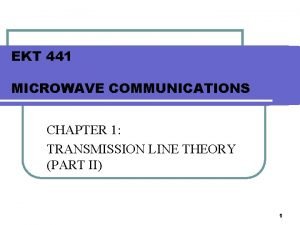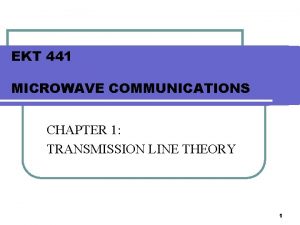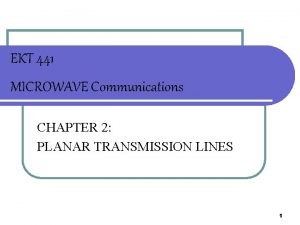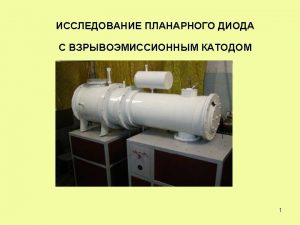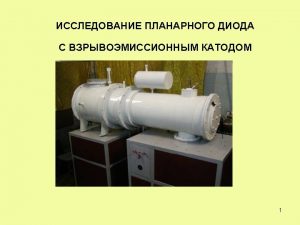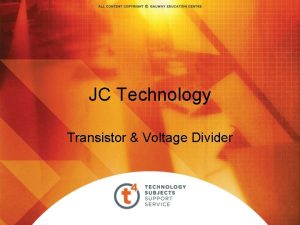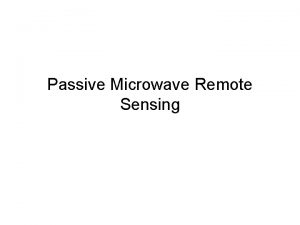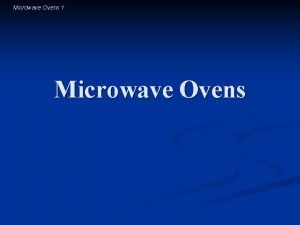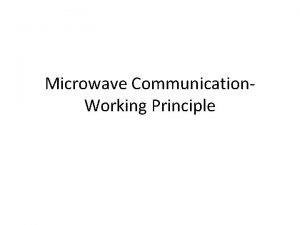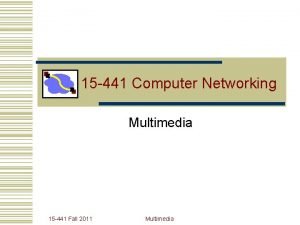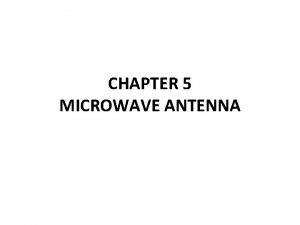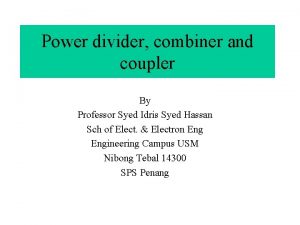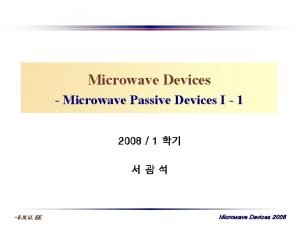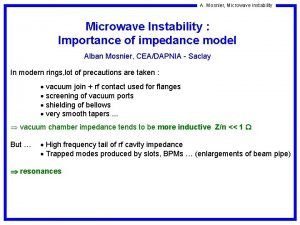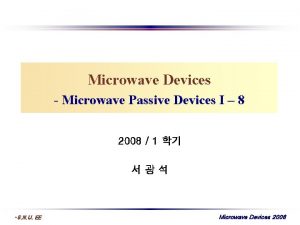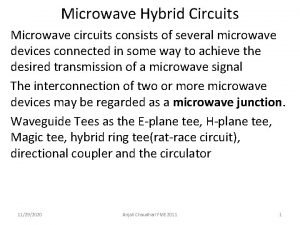EKT 441 MICROWAVE COMMUNICATIONS CHAPTER 5 POWER DIVIDER






![Three Port Network S Parameter If all the three ports are matched the [S] Three Port Network S Parameter If all the three ports are matched the [S]](https://slidetodoc.com/presentation_image_h2/5a6b13d694f01955ae33cbd2cef8c6f3/image-7.jpg)


![Three Port Network S Parameter [5. 3 a] [5. 3 b] [5. 3 c] Three Port Network S Parameter [5. 3 a] [5. 3 b] [5. 3 c]](https://slidetodoc.com/presentation_image_h2/5a6b13d694f01955ae33cbd2cef8c6f3/image-10.jpg)

![THREE-PORT NETWORKS (T-JUNCTIONS) Figure 5. 2: the two types of circulators and their [S] THREE-PORT NETWORKS (T-JUNCTIONS) Figure 5. 2: the two types of circulators and their [S]](https://slidetodoc.com/presentation_image_h2/5a6b13d694f01955ae33cbd2cef8c6f3/image-12.jpg)

![Three Port Network S Parameter • Then if the network is lossless, [S] must Three Port Network S Parameter • Then if the network is lossless, [S] must](https://slidetodoc.com/presentation_image_h2/5a6b13d694f01955ae33cbd2cef8c6f3/image-14.jpg)







![Four Port Networks The [S] matrix of a reciprocal four-port network matched at all Four Port Networks The [S] matrix of a reciprocal four-port network matched at all](https://slidetodoc.com/presentation_image_h2/5a6b13d694f01955ae33cbd2cef8c6f3/image-22.jpg)
































- Slides: 54

EKT 441 MICROWAVE COMMUNICATIONS CHAPTER 5: POWER DIVIDER & COUPLERS 1

INTRODUCTION l In some cases, power from a single microwave power amplifier may be insufficient to power up a device (e. g a radar transmitter) l In such case, several power amplifiers may be used with their power added using power combiners l Microwave couplers allows construction of balanced amplifiers that feature constant gain over wide bandwidth l Passive 3 - and 4 -port passive components are used to solve problems like this, which will be the main focus of this chapter. 2

INTRODUCTION • • Three Port Network S Parameter Matrix Review of Power Dividers and Couplers Directional Coupler Hybrid Couplers The Lossless T Junction T Example The Resistive Divider Scattering Matrix of the Resistive Divider 3

INTRODUCTION Power dividers and couplers are passive microwave components used for power division or power combining. l Power division: an input signal is divided by the coupler into two (or more) signal or lesser power. l Power divider types: 1. equal division (3 d. B) type (T-junctions & circulators) 2. unequal power division type (Resistive power divider) l 4

INTRODUCTION l l Directional coupler – an arbitrary power division. Hybrid junctions – equal power division. Hybrid junctions have either: 1. a 90º (quadrature) or 2. a 180º (magic-T) phase shift between the output ports. Some general properties of the 3 - and 4 -port networks will be first analyzed and discussed. 5

Three Port Network S Parameter The scattering matrix of an arbitrary three port network has nine independent variables: If all the components of the network are passive and it does not contain any active component, then its S parameter matrix must be reciprocal. The [S] matrix will also be symmetric. Usually to avoid power loss, we would like to have a network that is matched at all ports and is lossless. However, it is impossible to construct a three port lossless reciprocal network that is matched at all ports. 6
![Three Port Network S Parameter If all the three ports are matched the S Three Port Network S Parameter If all the three ports are matched the [S]](https://slidetodoc.com/presentation_image_h2/5a6b13d694f01955ae33cbd2cef8c6f3/image-7.jpg)
Three Port Network S Parameter If all the three ports are matched the [S] matrix can be written as: If the three port network is not reciprocal then and its [S] matrix will not be symmetric. 7

Three Port Network S Parameter • The simplest type of power divider is a T-junction, which is a three-port network with two inputs and one output. • The scattering matrix of an arbitrary three-port network has nine independent elements. [5. 1] • If the component is passive and contains no anisotropic materials, then it must be reciprocal and its [S] matrix must be symmetric (Sij = Sji). • Usually, to avoid power loss, we would like to have a junction that is lossless and matched to all ports. 8

Three Port Network S Parameter If all ports are matched, the Sii = 0, and if the network is reciprocal the scattering matrix of [5. 1] reduces to: [5. 2] [5’] If the network is lossless, then the energy conversion [5’] requires that the scattering matrix be unitary, which leads to the following conditions: 9
![Three Port Network S Parameter 5 3 a 5 3 b 5 3 c Three Port Network S Parameter [5. 3 a] [5. 3 b] [5. 3 c]](https://slidetodoc.com/presentation_image_h2/5a6b13d694f01955ae33cbd2cef8c6f3/image-10.jpg)
Three Port Network S Parameter [5. 3 a] [5. 3 b] [5. 3 c] [5. 3 d] [5. 3 e] [5. 3 f] [5. 3 d-f] show that at least two of the three parameters (S 12, S 13, S 23) must be zero. 10

Three Port Network S Parameter • If the three-port network is nonreciprocal, then Sij ≠ Sji, and the condition of the input matching at all ports and energy conservation can be satisfied. • Such device is known as a circulator, and generally relies on an anisotropic material, such as ferrite to achieve nonreciprocal behavior. 11
![THREEPORT NETWORKS TJUNCTIONS Figure 5 2 the two types of circulators and their S THREE-PORT NETWORKS (T-JUNCTIONS) Figure 5. 2: the two types of circulators and their [S]](https://slidetodoc.com/presentation_image_h2/5a6b13d694f01955ae33cbd2cef8c6f3/image-12.jpg)
THREE-PORT NETWORKS (T-JUNCTIONS) Figure 5. 2: the two types of circulators and their [S] matrices. (the phase references for the ports are arbitrary) (a) Clockwise circulation. (b) Counterclockwise circulation. 12

THREE-PORT NETWORKS (T-JUNCTIONS) Figure 5. 3: A reciprocal, lossless three-port network matched at ports 1 and 2 13
![Three Port Network S Parameter Then if the network is lossless S must Three Port Network S Parameter • Then if the network is lossless, [S] must](https://slidetodoc.com/presentation_image_h2/5a6b13d694f01955ae33cbd2cef8c6f3/image-14.jpg)
Three Port Network S Parameter • Then if the network is lossless, [S] must be unitary, which implies the following: [5. 4 a] [5. 4 b] [5. 4 c] [5. 4 d] [5. 4 e] [5. 4 f] 14

Three Port Network S Parameter These equations can be satisfied in one or two ways. Either: [5. 5 a] [5. 5 b] or [5. 5 c] [5. 5 d] This result shows that Sij ≠ Sji for i ≠ j, which implies that the device must be nonreciprocal. 15

INTRODUCTION • • Three Port Network S Parameter Matrix Review of Power Dividers and Couplers Directional Coupler Hybrid Couplers The Lossless T Junction T Example The Resistive Divider Scattering Matrix of the Resistive Divider 16

Power Dividers and Couplers In low frequency design, it is common to sum signals by adding their currents or voltages. In high frequency design direct summation is not used. Instead there is a class of circuits used to sum or split power. Power Splitter Power Combiner 17

Power Dividers and Couplers Two basic types of these circuits are: Power Divider and Power Combiner. Three port networks are shown here, but both dividers and combiners can be multi-port networks. The most common value for in splitter is – 3 d. B (when P 2 = P 3 ). The power ratio in splitter can range up to – 40 d. B for one path. 18

Power Dividers and Couplers Power division and combining can be achieved with 3 port networks P 1=P 2+P 3 Divider or coupler P 2= P 1 Power division P 3=(1 - )P 1 P 2 Power combining P 3 is known as the division ratio 19

Power Dividers and Couplers An example of 1 to 4 power divider; 2 1 P 1 P 1 1 to 2 Power Divider (1 - 2) 1 P 1 2(1 - 1)P 1 1 to 2 Power Divider (1 - 2)(1 - 1)P 1 20

INTRODUCTION • • Three Port Network S Parameter Matrix Review of Power Dividers and Couplers Directional Coupler Hybrid Couplers The Lossless T Junction T Example The Resistive Divider Scattering Matrix of the Resistive Divider 21
![Four Port Networks The S matrix of a reciprocal fourport network matched at all Four Port Networks The [S] matrix of a reciprocal four-port network matched at all](https://slidetodoc.com/presentation_image_h2/5a6b13d694f01955ae33cbd2cef8c6f3/image-22.jpg)
Four Port Networks The [S] matrix of a reciprocal four-port network matched at all ports has the following form: [5. 6] 22

Four Port Networks For an ideal coupler, this network will be reciprocal, matched at each port, and will have no power delivered to the isolated port. The [S] matrix becomes 23

Directional Coupler One specific class of power divider is the directional coupler. This is a four port device that samples the power flowing into port 1 coupled in to port 3 (the coupled port) with the remainder of the power delivered to port 2 (the through port) and no power delivered to the isolated port. Input Isolated Directional Coupler Through Coupled Usually the isolated port is terminated within the coupler casing. In such case, the coupler appears to be a three port device. In ideal case no power is delivered to port 4 (the 24 isolated port).

Directional Coupler Input Isolated Directional Coupler Through Coupled Directional couplers are described by three specifications: • Coupling (C) - The ratio of input power to the couple power. • Directivity (D)- The ratio of coupled power to the power at the isolated port. • Isolation (I) – The ratio of input power to power out of the isolated port. 25

Directional Coupler Figure 5. 3: two commonly used symbols for directional couplers and power flow conventions. 26

Directional Coupler The basic operation of a directional coupler can be illustrated with the aid of Figure 5. 3, which shows two commonly used symbols for a directional coupler and the port definition. • A four port device with a property that a wave incident in port 1 couples ports 2 and 3 but not into port 4 as shown below • The structure has four ports input, direct(through), coupled and isolated. • The 3 important parameters describing the performance of coupler are; 1. C (coupling factor), 2. D (directivity) and 3. I (Isolation) 27

Directional Coupler • The following three quantities are generally used to characterize a directional coupler: 1. Coupling (C) – relates the coupled power (P 3) to the input power (P 1), that is; If all the ports are terminated in matched loads, the coupling coefficient becomes simply: 28

Directional Coupler 2. Directivity (D) – characterizes the coupler’s ability to direct energy only to the desired port. When all ports are matched, it is given by; 29

Directional Coupler 3. Isolation (I) – is a measure of how much input power exits the isolated port. It is given by; When all ports are matched, it is given by; Coupling and directivity level are also related to the isolation by the following; 30

Directional Coupler Another important parameter is the main line loss, also known as Insertion Loss (IL). This is the level of loss that is occurred by the coupler between the input (P 1) and through (P 2) ports. or for an perfectly matched network; 31

Hybrid Couplers Hybrid couplers are special cases of directional couplers, where the coupling factor is 3 d. B. l There are two types of hybrids. 1) The quadrature hybrid has a 90 degree phase shift between port 2 and 3 when fed from port 1, with the following [S] matrix. l 2) The magic-T hybrid or ratrace hybrid has a 180 degree phase shift between port 2 and 3 when fed from port 4, with the following [S] matrix: 32

Example Hybrid couplers are special cases of directional couplers, where the coupling factor is 3 d. B. l There are two types of hybrids. 1) The quadrature hybrid has a 90 degree phase shift between port 2 and 3 when fed from port 1, with the following [S] matrix. l 2) The magic-T hybrid or ratrace hybrid has a 180 degree phase shift between port 2 and 3 when fed from port 4, with the following [S] matrix: 33

INTRODUCTION • • Three Port Network S Parameter Matrix Review of Power Dividers and Couplers Directional Coupler Hybrid Couplers The Lossless T Junction T Example The Resistive Divider Scattering Matrix of the Resistive Divider 34

T Junction Figure 5. 4: Various T-junction power dividers. (a) E plane waveguide T. (b) H plane waveguide T. (c) Microstrip T-junction. 35

The Lossless T Junction The simplest type of power divider is the T junction can be implemented using virtually any type of transmission line. However, the T junction is very simple to implement, it must be treated with care because it does not offer any isolation between its ports. Matching requirement for the T junction input: 36

The Lossless T Junction In general, the fringing fields and higher order modes associated with the discontinuity at such a junction, leading to store energy that can be accounted for by a lumped susceptance, B. In order for divider to be matched to the input line of characteristic impedance, Z 0, it must have: [5. 8] If the transmission lines are assumed to be lossless (or low loss), then the characteristic impedances are real. If assume that B = 0, then [5. 8] reduces to: [5. 9] 37

The Lossless T Junction In order for the input port to be matched, the output lines must be matched (terminated in their characteristic impedance). The power dividing ratio can be selected by using different values of characteristic impedance for ports 2 and 3. 38

The Lossless T Junction Input matching requirement: Therefore, the input to the T junction can be matched through the correct choice of impedances in port 2 and 3. What about matching of port 2 and 3? 39

The Lossless T Junction Now lets consider matching of port 2. If port 2 is matched, then 2 = 0 and we will have: Substitution of yields Z 2 = 0. Which shows that the lossless T junction cannot be matched at all three ports simultaneously. (Problem 7. 1 Pozar) 40

Junction T Example The resistive power divider for an equal power split. If the T junction contains lossy components then it is possible to match all the three ports. In this case the signal power will be reduced due to loss in the junction. 41

INTRODUCTION • • Three Port Network S Parameter Matrix Review of Power Dividers and Couplers Directional Coupler Hybrid Couplers The Lossless T Junction T Example The Resistive Divider Scattering Matrix of the Resistive Divider 42

The Resistive Divider Assuming that all the lumped-element resistors are terminated in the characteristic impedance Zo, the input impedance looking into any port is: Since the network is symmetric from all three ports, the output ports are also matched. Therefore, S 11=S 22=S 33=0 43

The Resistive Divider The voltage at the center of the junction is: The output voltages V 2 and V 3 are equal to: 44

Scattering Matrix of the Resistive Divider Since the network is symmetric and reciprocal, S 21=S 31=S 23=1/2. Thus, the output power is – 6 d. B below the input power level (lossy). The power delivered to the input and outputs of the divider are: Half of the supplied power is dissipated in the resistors. 45

Example – T Junction A lossless T junction power divider has a source impedance of 50 Ohms. Find the output characteristics impedance so that the input power is divided in a 2: 1 ratio. Compute the reflection coefficients seen looking into the output ports. 46

Example – T Junction If the voltage at the junction is V 0, as shown in the figure, the input power to the divider is Then the output powers are: 47

Example – T Junction The results yields the characteristic impedance as: The input impedance to the junction is; Looking into the 150 Ω output line, we see an impedance of 50||75 = 30 Ω, while at the 75 Ω output line, we see an impedance of 150||50 = 37. 5 Ω. 48

Example – T Junction Thus the reflection coefficient looking into these ports are: 49

Example – T Junction Including quarterwave transformer into the T junction power divider and compensation l/4 P 2 P 1 Zc = 50 ohm 150 ohm 86. 6 75 ohm l/4 50 P 2 Recommended quarter wavelength 61. 24 50 50

THE WILKINSON POWER DIVIDER Figure 5. 6: The Wilkinson power divider. (a) an equal-split Wilkinson power divider in microstrip form. (b) Equivalent transmission line circuit. 51

THE WILKINSON POWER DIVIDER The Wilkinson power divider is such a network, with the useful property of being lossless when the output ports are matched; that is, only reflected power is dissipated. The Wilkinson power divider can be made with arbitrary power division, but we will first consider the equal-split (3 d. B) case. This divider is often made in microstrip or stripline form. 52

THE WILKINSON POWER DIVIDER 53

THE WILKINSON POWER DIVIDER 54
 Unilab
Unilab Kalkulationsberechnung
Kalkulationsberechnung Solar power satellites and microwave power transmission
Solar power satellites and microwave power transmission T junction power divider
T junction power divider T junction power divider
T junction power divider T junction power divider
T junction power divider Ac power formula
Ac power formula Cpsc441
Cpsc441 Jupiter radius in km
Jupiter radius in km Dchr health insurance
Dchr health insurance Cmu 15-441
Cmu 15-441 Eecs 441
Eecs 441 Cpsc 441 assignment 1
Cpsc 441 assignment 1 Cpsc441
Cpsc441 Broad phase vs narrow phase
Broad phase vs narrow phase Ist 441
Ist 441 University of calgary orientation
University of calgary orientation Ist 441
Ist 441 Liedboek 441
Liedboek 441 Ece
Ece Ece
Ece Ece 441
Ece 441 Ece transformer
Ece transformer Ece 441
Ece 441 Ece
Ece Calculati 441-(-15)2
Calculati 441-(-15)2 Ece
Ece Scott schaefer tamu
Scott schaefer tamu Cpsc 441
Cpsc 441 Cmu 15-441
Cmu 15-441 Transistor stabilization
Transistor stabilization 16 bit divider verilog code
16 bit divider verilog code 8 bit divider
8 bit divider Dividend and divisor
Dividend and divisor Lone divider method
Lone divider method File panitia bahasa inggeris
File panitia bahasa inggeris Susceptance
Susceptance Base emitter loop
Base emitter loop Voltage divider formula
Voltage divider formula Voltage divider rule
Voltage divider rule How many syllables does nature have
How many syllables does nature have Voltage divider formula
Voltage divider formula Divider chooser method
Divider chooser method Flow control valve symbol
Flow control valve symbol Current dividers
Current dividers Dc load line for voltage divider bias
Dc load line for voltage divider bias Vcc=icrc+vce
Vcc=icrc+vce Divider
Divider Voltage division
Voltage division Electronics, photonics and device physics
Electronics, photonics and device physics Current divider rule
Current divider rule Reference divider
Reference divider Current dividing rule
Current dividing rule Q transform
Q transform Xilinx clock divider
Xilinx clock divider
